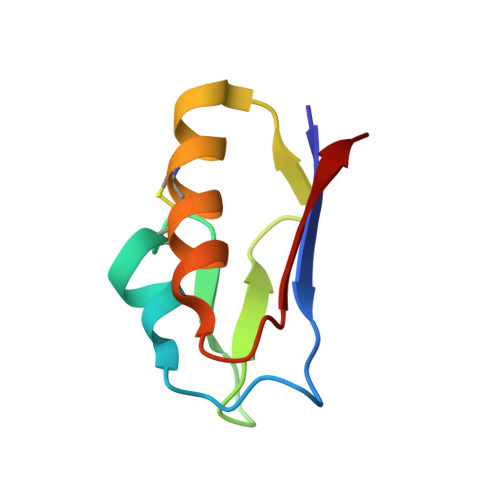Heterometallic [AgFe(3)S (4)] ferredoxin variants: synthesis, characterization, and the first crystal structure of an engineered heterometallic iron-sulfur protein.
Martic, M., Jakab-Simon, I.N., Haahr, L.T., Hagen, W.R., Christensen, H.E.(2013) J Biol Inorg Chem 18: 261-276
- PubMed: 23296387
- DOI: https://doi.org/10.1007/s00775-012-0971-3
- Primary Citation of Related Structures:
4DHV - PubMed Abstract:
Heterometallic [AgFe(3)S(4)] iron-sulfur clusters assembled in wild-type Pyrococcus furiosus ferredoxin and two variants, D14C and D14H, are characterized. The crystal structure of the [AgFe(3)S(4)] D14C variant shows that the silver(I) ion is indeed part of the cluster and is coordinated to the thiolate group of residue 14. Cyclic voltammetry shows one redox pair with a reduction potential of +220 mV versus the standard hydrogen electrode which is assigned to the [AgFe(3)S(4)](2+/+) couple. The oxidized form of the [AgFe(3)S(4)] D14C variant is stable in the presence of dioxygen, whereas the oxidized forms of the [AgFe(3)S(4)] wild type and D14H variants convert to the [Fe(3)S(4)] ferredoxin form. The monovalent d (10) silver(I) ion stabilizes the [Fe(3)S(4)](+/0) cluster fragment, as opposed to divalent d (10) metal ions, resulting in more than 0.4 V difference in reduction potentials between the silver(I) and, e.g., zinc(II) heterometallic [MFe(3)S(4)] ferredoxins. The trend in reduction potentials for the variants containing the [AgFe(3)S(4)] cluster is wild type ≤ D14C < D14H and shows the same trend as reported for the variants containing the [Fe(3)S(4)] cluster, but is different from the D14C < D14H < wild type trend reported for the [Fe(4)S(4)] ferredoxin. The similarity in the reduction potential trend for the variants containing the heterometallic [AgFe(3)S(4)] cluster and the [Fe(3)S(4)] cluster can be rationalized in terms of the electrostatic influence of the residue 14 side chains, rather than the dissociation constant of this residue, as is the case for [Fe(4)S(4)] ferredoxins. The trends in reduction potentials are in line with there being no electronic coupling between the silver(I) ion and the Fe(3)S(4) fragment.
Organizational Affiliation:
Department of Chemistry, Technical University of Denmark, Kemitorvet 207, 2800, Kongens Lyngby, Denmark.
















